At the beginning of June, my wife and I made the move from Chicago to my pretty rural home town of Ithaca, New York. If people have heard of Ithaca at all it's usually because it is the home of Cornell University, or Ithaca College. At first glance, there doesn’t seem to be much to draw people here other than those two schools, but neither of them are the reason for my return. You see, aside from being an academic enclave, Ithaca also has some of the best growing conditions you could hope to find for a wide variety of agricultural endeavors. The wine is amazing, as are the apples, berries, milk, cheese, squash, sweet corn, etc. Now of course this is great news for any chef who likes to cook with the freshest, most vibrant ingredients, but it's also a boon for anyone looking to grow their own garden.
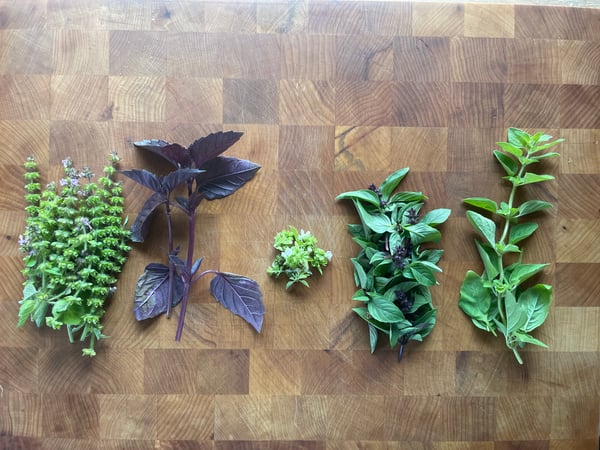
Living in Chicago, I always did my best to grow what I could on the little outdoor space, and even less sunlight, that I had access to. I never had great success though, and moving out to a rural setting with long sunny days, and rich dark soil represented my first opportunity to plant a real garden in my adult life. It took us a while after moving in to get the garden beds turned over (moving when both my wife and I were in the deepest throes of Covid infection certainly didn’t help speed anything up), we managed to get plants in the ground this last weekend.
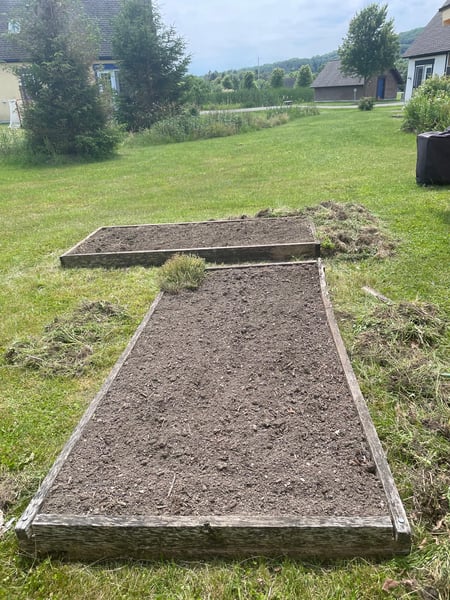
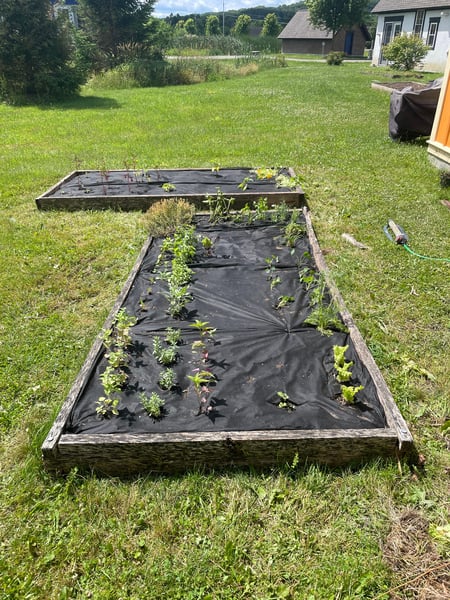
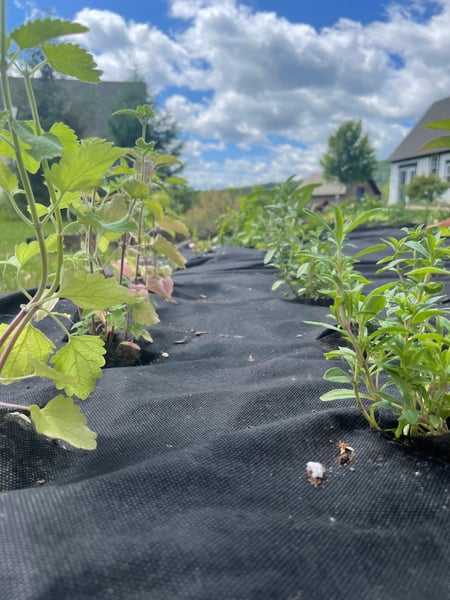 Because its so late in the season, some of the plant starts we got, herbs mostly, had already begun to produce flowers. This is not ideal since once the plant has gone to seed it doesn’t feel the need to put energy into leaf growth any longer. The main offenders here were the basil, particularly my two favorite basil varieties (Thai basil and Tulsi (or holy) basil) which had already begun to put up lots of flowers. In order to get them to start growing leaves again, and to help make them bushier instead of just taller, I had to prune off a good bit of the plants.
Because its so late in the season, some of the plant starts we got, herbs mostly, had already begun to produce flowers. This is not ideal since once the plant has gone to seed it doesn’t feel the need to put energy into leaf growth any longer. The main offenders here were the basil, particularly my two favorite basil varieties (Thai basil and Tulsi (or holy) basil) which had already begun to put up lots of flowers. In order to get them to start growing leaves again, and to help make them bushier instead of just taller, I had to prune off a good bit of the plants.
 This is always an emotionally fraught process for a novice gardener like myself. I’m always worried I’ll do irreparable damage, especially when I'm pruning so much. The other thing that makes me hesitate to prune heavily is that I end up with all this incredibly fragrant basil, and I don’t have anything to do with it. Throwing it away or even tossing it on the compost pile just feels wrong; it's so delicious! So instead of simply discarding all the beautiful flowers and leaves of the basil I trimmed I decided I would make it into an infused vinegar.
This is always an emotionally fraught process for a novice gardener like myself. I’m always worried I’ll do irreparable damage, especially when I'm pruning so much. The other thing that makes me hesitate to prune heavily is that I end up with all this incredibly fragrant basil, and I don’t have anything to do with it. Throwing it away or even tossing it on the compost pile just feels wrong; it's so delicious! So instead of simply discarding all the beautiful flowers and leaves of the basil I trimmed I decided I would make it into an infused vinegar.
Infused vinegars are a great way to preserve the flavors and abundance of your summer garden, and they are trivially easy to prepare. All I did here was to cram everything I trimmed off the basil in my garden into a small glass container, and add about a cup and a half of distilled white vinegar. It's also best to wash your herbs before adding them to the vinegar in case there are any little insect friends living in the leaves.
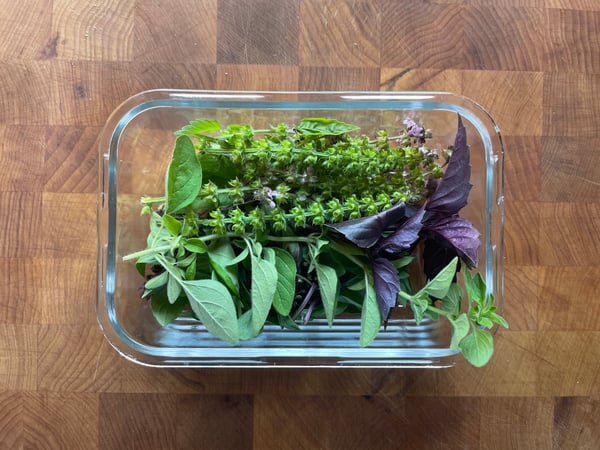
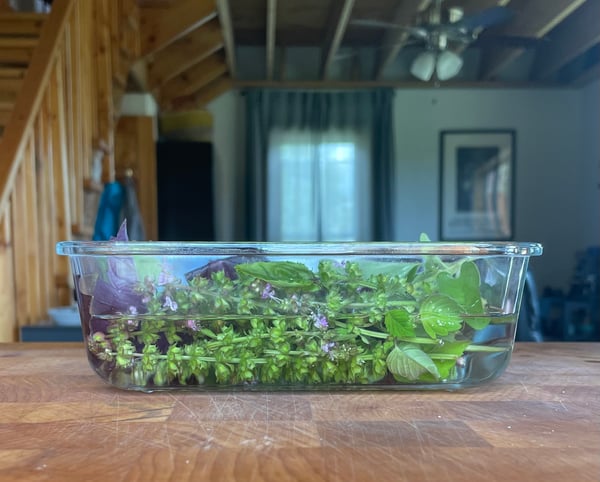 Though I like distilled vinegar for making infusions because of its neutral flavor, you can use any type of vinegar you like. Feel free to change up the herbs you use as well. Though basil makes a lovely vinegar infusion, any aromatic herb, spice, flower or vegetable will work.
Though I like distilled vinegar for making infusions because of its neutral flavor, you can use any type of vinegar you like. Feel free to change up the herbs you use as well. Though basil makes a lovely vinegar infusion, any aromatic herb, spice, flower or vegetable will work.
If you want to be extra thorough, you could weigh down your leaves with something non-reactive in order to make sure you’re getting everything submerged. I didn’t worry about that here because as the acid in the vinegar breaks down the leaves and flowers, everything should settle to the bottom and keep itself submerged. From here, I just popped an airtight lid on and let it infuse.
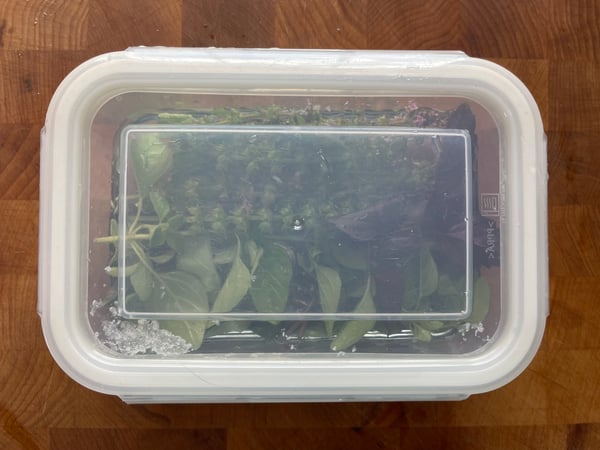 The infusion will probably take about a week, but, just like with cooking, there’s no replacement for just tasting it every day or so, and letting it go until you like the flavor. You also don’t need to necessarily use the same herb to vinegar ratio I have here. My infusion is pretty densely packed, and you could definitely get away with a little less plant material if you don’t have quite as vigorous a harvest as I did here.
The infusion will probably take about a week, but, just like with cooking, there’s no replacement for just tasting it every day or so, and letting it go until you like the flavor. You also don’t need to necessarily use the same herb to vinegar ratio I have here. My infusion is pretty densely packed, and you could definitely get away with a little less plant material if you don’t have quite as vigorous a harvest as I did here.
If you like the idea of preserving the bounty of summer for use into the more dour portions of the year I recommend joining me for our virtual class on pickles and jams coming up on Sunday, July 10 at 3pm CST. We’ll cover the basics of making refrigerator jams, pickles and jellies so you can enjoy the farm fresh flavors of summer for months to come. I hope to see you there!











